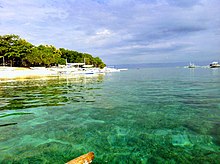 Aerial view of Panglao Island in August 2023 Aerial view of Panglao Island in August 2023 | |
  | |
| Geography | |
|---|---|
| Location | Bohol Sea |
| Coordinates | 9°36′N 123°49′E / 9.6°N 123.82°E / 9.6; 123.82 |
| Area | 91.12 km (35.18 sq mi) |
| Length | 16 km (9.9 mi) |
| Width | 7.5 km (4.66 mi) |
| Administration | |
| Philippines | |
| Region | Central Visayas |
| Province | Bohol |
| Municipalities | |
| Largest settlement | Dauis (pop. 52,492) |
| Demographics | |
| Population | 92,331 (2015) |
| Pop. density | 870/km (2250/sq mi) |
| Additional information | |
Panglao is an island in the north Bohol Sea, located in the Central Visayas region of the Visayas island group, in the south-central Philippines.
Geography

The island has an area of 91.12 square kilometres (35.18 sq mi). It is within Bohol Province, and comprises two municipalities: Dauis and Panglao. Panglao island is located southwest of the island of Bohol and east and south of Cebu.
Panglao has a terrain that ranges from plain, hilly to mountainous. Panglao is made of Maribojoc limestone, the youngest of the limestone units found in the western area of Bohol. The limestone composition delayed the development of the international airport as coralline limestone is soluble which causes formation of caves and sinkholes. One interesting geological feature found in the island is the Hinagdanan Cave which has an underground water source. The cave is an important water source as the island has no rivers or lakes.
Panglao is a popular tourist destination in the Philippines and includes several small islands, such as Gak-ang, Pontod, and Balicasag and is close to Pamalican island.
According to the 2015 census, it has a population of 79,216.
History
See also: Bo-olPrecolonial era
Panglao was known to Chinese, Malay, Siamese and Indonesian traders. It once housed the precolonial polity of Bo-ol.
Biodiversity

About 250 new species of crustaceans and 2500 new species of mollusks were found around the island. The discovery was the work of the Panglao Marine Biodiversity Project. The project found that Panglao alone has more marine biodiversity than Japan and the Mediterranean Sea.
The Panglao Island Protected Seascape was declared a national park under Republic Act No. 11038 (Expanded National Integrated Protected Areas System Act of 2018) signed by President Rodrigo Duterte in July 2018.
Tourism

Panglao island is one of the main tourist destinations on the Philippines. Alona Beach is the most popular tourist spot on the island, noted for its white sand and clear water. There are also a lot of attractions to do for tourists such as scuba diving, island hopping, dolphin watching, snorkeling, kitesurfing and fishing.
Transportation
Bohol–Panglao International Airport (TAG/RPSP) is the primary international airport serving the province of Bohol. The airport opened in November 2018, replacing the former Tagbilaran Airport and now serving Panglao Island and the rest of Bohol. There are almost hourly daytime flights to and from Manila operated by Philippine Airlines, Cebu Pacific, and Air Asia. There are also flights to and from Davao and El Nido every second day. International flights recommenced after the pandemic to Korea with up to 3 flights a day, as well as scheduled charter flights from China. It is less than 2 hours of travel time by fast ferry to Cebu.
There is a regular air-conditioned bus service from the airport to Tagbilaran City (Island City Mall and v/v PHP 50 each way) and a circular route to Alona beach. Short trips are usually by Tuk-Tuks or motor tricycle taxis, fares negotiable.
The island is connected with the Bohol main island by two bridges namely the Cong. Suarez Bridge and the Gov. Borja Bridge. A third bridge, also connecting the island to mainland Bohol, is under construction.
See also
References
- "Philippine Standard Geographic Code (PSGC) - Province: BOHOL". nap.psa.gov.ph. Philippine Statistics Authority. Archived from the original on April 18, 2018. Retrieved April 17, 2018.
- ^ Census of Population (2020). "Region VII (Central Visayas)". Total Population by Province, City, Municipality and Barangay. Philippine Statistics Authority. Retrieved July 8, 2021.
- Pedroso, Kate (March 2, 2007). "Panglao, Bohol: a center of marine biodiversity". Philippine Daily Inquirer. Archived from the original on February 21, 2013. Retrieved June 15, 2012.
- Aurelio, Julie M. (July 7, 2018). "Expanded Nipas law creates 94 more nat'l parks across PH". Philippine Daily Inquirer. Archived from the original on October 21, 2024. Retrieved October 21, 2024.
External links
 Panglao travel guide from Wikivoyage
Panglao travel guide from Wikivoyage- Panglao Island, Bohol - UNESCO World Heritage Centre
- Giselle P. B. Samonte-Tan; Alan T. White; Mary Ann Tercero; John Diviva; Esperanza Tabara; Ciemon Caballes (2007). "Economic Valuation of Coastal and Marine Resources: Bohol Marine Triangle, Philippines" (PDF). Coastal Management. 35 (3): 319–338. doi:10.1080/08920750601169634. ISSN 0892-0753.
| Protected areas in Central Visayas | |
|---|---|
| National parks | |
| Natural parks | |
| Natural monuments | |
| Protected landscapes | |
| Protected landscapes and seascapes |
|
| Protected seascapes | |
| Game refuge and bird sanctuaries | |
| Watershed forest reserves |
|
| Wilderness areas |
|
| Protected areas of the Philippines | |